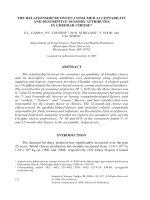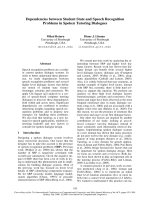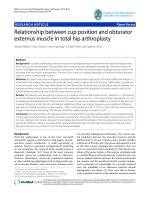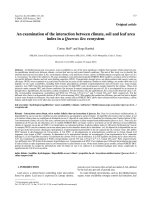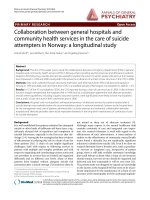Ultrasonographic assessment of embryonic loss between days 28 and 45 post insemination in crossbred dairy cattle of Kerala
Bạn đang xem bản rút gọn của tài liệu. Xem và tải ngay bản đầy đủ của tài liệu tại đây (417.68 KB, 12 trang )
Int.J.Curr.Microbiol.App.Sci (2020) 9(5): 328-339
International Journal of Current Microbiology and Applied Sciences
ISSN: 2319-7706 Volume 9 Number 5 (2020)
Journal homepage:
Original Research Article
/>
Ultrasonographic Assessment of Embryonic Loss between Days 28 And 45
Post Insemination in Crossbred Dairy Cattle of Kerala
E. Niyas1*, Shibu Simon1, Reni John1, Ani S. Das2, D. S. Suprith2,
S. Reshma2 and Anugraha Mercy Easaw2
1
ULF&FRDS, College of Veterinary and Animal Sciences, Mannuthy, Thrissur,
Kerala, India, 680651
2
College of Veterinary and Animal Sciences, Mannuthy, Thrissur, Kerala, India, 680651
*Corresponding author
ABSTRACT
Keywords
Embryonic loss,
ultrasonography,
crossbred cattle,
inter-calving
interval
Article Info
Accepted:
05 April 2020
Available Online:
10 May 2020
Embryonic mortality (EM) is a major concern in the dairy industry across the world and it
occurs due to loss of conceptus following fertilization until days 42-45 of pregnancy. The
present study was carried out with the objective to detect EM in the crossbred cattle at the
University Livestock Farm, Mannuthy, Kerala Veterinary and Animal Sciences University
during the period from September 2017 to August 2019. Among the breedable animals
inseminated at spontaneous oestrus, non-return animals (n=362) were selected for the
study. Transrectal ultrasonography (TRUS) using a 7.5 MHz transducer was performed on
days 28 and 45, respectively to diagnose pregnancy and to detect embryonic mortality if
any. Out of 362 animals which exhibited non-return to oestrus, 73.76 per cent (n=267)
were found positive for pregnancy on day 28 and out of these, 95.88 per cent animals
(n=256) were having viable embryo with detectable heart beat on day 45.Thus, the
incidence of EM in the current investigation was 4.12 per cent between days 28 and 45
post- service. In conclusion, use of ultrasonography to detect embryonic loss and
pathological conditions, at the early stages of gestation helps to reduce the inter-calving
interval, a key factor of successful dairying.
consequent effects on reproductive efficiency,
production and profitability. Approximately
30 per cent of pregnancies are lost in the form
of embryonic death causing an increase in the
successive calving interval, thereby ultimately
affecting the success of reproductive
programs in dairy cows (Chaudhary and
Purohit, 2012). Majority of embryonic losses
occur before 16 days of breeding although
Introduction
Embryonic mortality is the prime cause of
economic loss in dairy industry and is
generally defined as the loss of conceptus that
occurs during the first 45 days of pregnancy,
the period from conception to completion of
organogenesis. Direct effects of EM are
reflected in reduced conception rates with
328
Int.J.Curr.Microbiol.App.Sci (2020) 9(5): 328-339
there are reports on greater incidence of losses
before day 8 in high producing dairy cows.
Early embryonic mortality leads to repeat
breeding, increased cost of artificial
insemination and treatment, extended calving
intervals and prolonged dry period resulting
in reduced milk production and net calf crop
(Bajaj, 2001).
progesterone concentration (Stronge et al.,
2005) or pregnancy specific proteins
(Prvanovic et al., 2009), transrectal
ultrasonography (Romano et al., 2006) and
transrectal palpation (Balhara et al., 2013;
Bekele et al., 2016).
Ultrasound has previously been reported to be
an economically profitable reproductive
management strategy for dairy farms (Beal et
al., 1992) and under Indian scenario the
incidence of early embryonic mortality has
not been studied in detail so far. With the
advent of real time ultrasound in modern
times, the foresaid can be utilised in
organized farms to detect early pregnancy and
embryonic mortalities. Hence the present
study was carried out with the objective to
detect EM in the crossbred cattle from day 28
to 45 post-insemination.
Late embryonic mortality causes serious
economic losses since it is often recognized
extremely late to rebreed females. About 80
per cent of the embryonic loss occurs before
days 16 -17; 10 - 15 per cent between days 17
- 42 and 5 per cent after day 42. Earlier, it was
believed that the bovine conceptus gets
reabsorbed after early embryonic death, but
transrectal ultrasound examination has
demonstrated that the conceptus and its
breakdown products apparently are eliminated
by expulsion through the cervix, which either
goes unnoticed or appear as a vulvar
discharge of clear mucus (Kastelic et al.,
1991).
Materials and Methods
The present study was carried out with the
objective of utilizing real time B-mode TRUS
in the detection of embryonic loss in a herd of
crossbred cows which are maintained under
identical feeding and management conditions
at the University Livestock Farm, Mannuthy,
Kerala Veterinary and Animal Sciences
University. The study was undertaken during
September 2017 to August 2019. Animals
selected for experiments were free from any
kind of anatomical and reproductive
disorders, were clinically healthy and had a
body condition score (BCS) of over 2.5 on a
scale from 1 to 5 (Edmonson et al., 1989).
Mainly infectious and hormonal factors may
participate in embryonic mortalities (Bajaj
and Sharma, 2011). Among the infectious
factors, viral, bacterial, protozoal and
mycoplasmal infections result in embryonic
death, indirectly by systemic effects via
septicemia, viremia or toxemia in the dam or
directly
affecting
the
embryo
or
contaminating the uterine environment.
Embryonic mortality caused by systemic
pathogens is usually depicted by fever or
pyrexia during the infection. Elevated body
temperature present in the first stage of
pregnancy can lead to early embryonic death
as a result of denaturation of embryonic
proteins. Luteal insufficiency during post
insemination period is considered as one of
the predisposing factors leading to EM
(Diskin and Moris, 2008).
Embryonic
mortality can be diagnosed by using a variety
of techniques including measurement of milk
The age group and body weight of the
animals ranged between 2 to11years and 300
to 450 kg, respectively. All the breedable
animals detected at spontaneous oestrus were
subjected to artificial insemination according
to AM/PM rule and were inseminated with
elite quality frozen semen after proper
thawing.
329
Int.J.Curr.Microbiol.App.Sci (2020) 9(5): 328-339
Re-insemination after 24h was carried out in
those cows in which oestrous signs persisted.
TRUS was done with a real time colour
Doppler ultrasound scanner (Mylab™
Gamma, EsoateSpA, Italy) equipped with
liner array, 5-10 MHz frequency transrectal
transducer (SV3513, Esaote Europe B.V,
Netherland).The gain, brightness and contrast
were set optimally for each examination.
beats were used as the main criteria to assess
the viability of the embryo and the heart beat
was observed within the cranial, cone-shaped
thorax of the embryo.
Re-examination at day 45 post AI
Animals which were diagnosed as pregnant at
day 28 by the presence of viable embryo were
subjected to a transrectal sonographic reexamination, for detecting embryonic loss, if
any. Such embryonic mortality was assessed
on the basis of observing changes in the
echogenicity of the uterine contents and/or
loss of amniotic and allantoic fluid from the
uterus.
Early pregnancy diagnosis at day 28 post
AI
Among all the inseminated animals, those
exhibited non-return to oestrus (n= 362) were
subjected to transrectal real time B-mode and
Doppler ultrasonography. A real time B-mode
ultrasound scanner equipped with a linear
array transrectal multi-frequency transducer
using frequency of 7.5 MHz was used to
diagnose pregnancy at day 28 postinsemination. After proper restraining of the
animal the faecal material was removed from
the rectum. The transducer and the sleeved
arm of the examiner were lubricated with
ultrasound gel to facilitate smooth insertion
through the anal sphincter and to establish
good contact with the floor of the rectal
mucosa. The transducer was safeguarded
within the hand before its insertion into the
rectum. The transducer was positioned dorsal
to the genital tract and slowly advanced
cranially. Initially the corpus luteum was
located by scanning both the ovaries with
controlled method of holding the probes,
without manipulating the ovarian position.
After initial orientation of the CL, ipsilateral
uterine horn was scanned over its dorsal
surface followed by the lateral surface for
detecting embryonic vesicle or embryo. A
presumptive diagnosis of pregnancy was
made if an anechoic fluid area was seen in the
uterine lumen. Further examination was
carried out to visualise embryo within the
uterine lumen, and if observed, it confirmed
the diagnosis of pregnancy. Embryonic heart
Results and Discussion
Early pregnancy diagnosis at day 28 post
AI
Among all the inseminated animals, those
exhibited non-return to oestrus (n= 362) were
subjected to TRUS. The uterus was located
well and was visualized through all sides with
the transducer in all the animals. Thus, the
chances of missing the embryonic vesicle
were negligible. Functional corpus luteum
(CL)
was
detected
using
B-mode
ultrasonography and its blood flow was
assessed by the Doppler system (Fig 1).
Positive diagnosis of pregnancy was based on
the presence of a functional CL with active
blood flow and anechoic round area of
varying size in the lumen of uterine horn
representing the fluid filled allantoic cavity.
In the anechoic vesicle, echogenic embryo
with heartbeat was identified (Fig 2 and Fig
3). The embryonic heart beats were used as
the main criteria to assess the viability of the
embryo and the heart beat was observed
within the cranial, cone-shaped thorax of the
embryo and the blood flow to heart was
assessed by using Doppler system.
330
Int.J.Curr.Microbiol.App.Sci (2020) 9(5): 328-339
Out of 362 non- return animals 267 animals
(73.76 %) were found positive for pregnancy
on day 28. Among the non-return cows 16.85
per cent (n= 61/362) had shown prolonged
interoestrus interval (>24 days as against the
normal cycle length of 18-24 days), which
could be attributed to EED.
noticed (Fig 7). Vaginal discharge was
noticed for a few days, along with cessation
of the luteal blood flow (Fig 8), disappearance
of embryo debris and fetal membrane
observed by day 49 (Fig 9) and the uterus
returned to normal non gravid state by day 52
(Fig 10).
Re-examination for pregnancy on day 45
post AI
Discussion
The prime considerations to reduce the intercalving interval in dairy animals are early
diagnosis of pregnancy, identifying uterine or
ovarian pathological conditions and early
detection of those animals that fail to
conceive after service (Pieterse et al., 1990).
Ultrasonography has an advantage over
traditional method of rectal palpation in
pregnancy diagnosis, detection of fetal
viability and assessment of embryonic loss
during early stages of gestation (Kastelic et
al., 1988 and Patel et al., 2005). The
introduction of ultrasonography for early
pregnancy diagnosis has allowed researchers
to differentiate the timing and extent of late
embryonic losses in cattle (Santos et al.,
2004).
Animals which were diagnosed as pregnant at
day 28 by the presence of viable embryo were
subjected to a transrectal sonographic reexamination at day 45 for detecting
embryonic
viability.
Pregnancy
was
confirmed based on the detection echogenic
embryo within the amniotic cavity surrounded
by increased amount of anechoic amniotic
and allantoic fluid. Out of 267 pregnant
animals, 95.88 per cent animals (n=256) had
viable embryo with heart beat on day 45 (Fig.
4 and 5) and 11 animals exhibited an
embryonic loss between days 28 and 45 post
AI. Thus, the incidence of embryonic
mortality in the current investigation was 4.12
per cent between days 28 and 45.
Embryo resorption/ expulsion
Early pregnancy diagnosis at day 28 post
AI
In majority of the animals (n=10/11) which
exhibited embryonic loss between day 28 and
45 post AI the process of fetal resorption or
expulsion was completed before day 45.
Transrectal ultrasonographic re-examination
on day 45 revealed absence of embryonic
debris, fetal membranes and uterine fluids and
those animals returned to oestrus after day 45.
One animal exhibited oestrus signs on day 42
post-AI, wherein Doppler ultrasonography
revealed reduced blood supply to the corpus
luteum verum (Fig 6) and the volume of
allantoic and amniotic fluid was greatly
reduced. No viable embryo was visible inside
the amniotic vesicle and an abnormal
thickening of fetal membranes could be
In the present study the pregnancy was
diagnosed as early as day 28 post-AI wherein
positive diagnoses of pregnancy by transrectal ultrasonography relied on the detection
of anechoic allantoic fluid and the embryo
proper. The study conducted by Romano et
al., 2006) agree with the fact that, TRUS can
be used for early pregnancy diagnosis in
bovines with a maximum sensitivity between
days 28 and 30 post-service. TRUS has
maximum sensitivity for pregnancy diagnosis in
cattle, TRUS for pregnancy diagnosis between
days 26 and 33 after breeding has a sensitivity
and specificity of 97.7 per cent and 87.7 per
cent respectively (Pieterse et al., 1990).
331
Int.J.Curr.Microbiol.App.Sci (2020) 9(5): 328-339
Contrarily,
sonographic
detection
of
pregnancy in cattle on days 23, 28, 35 post-AI
is less accurate than on day 42 and TRUS can
be perform with maximum sensitivity and
specificity between days 35- 42 in Zebu cattle
(Hadiya et al., 2015; Awasthi et al., 2011 and
Bhoraniya et al., 2011)
than that observed for beef cows (Beal et al.,
1992).
Embryo resorption/ expulsion
Embryonic death usually followed by either
resorption or expulsion of the embryo and
uterine contents. In our study, majority of the
animals which exhibited embryonic loss
between days 28 and 45 post- service did not
shown any evidence of embryo expulsion.
In the present study, among the non-return
cows 16.85 per cent (n= 61/362) animals had
shown prolonged interoestrus interval (>24
days as against the normal cycle length of 1824 days) which could be attributed to early
embryonic death (EED) that occurred after
the MRP.
One animal showed clear vaginal discharge
during the time of embryonic death and the
uterine contents were expelled through the
tract. This finding is in accordance with the
reports of Kastelic et al., (1991), wherein they
opined that TRUS examination has
demonstrated the embryo and its breakdown
products being apparently eliminated by
expulsion through the cervix, which either
goes unnoticed or appear as a vulvar
discharge of clear mucus.
Similar observations were reported by Noakes
et al., (2009), in which the animal will return
to normal oestrus if the embryonic death
occurs before the maternal recognition of
pregnancy (MRP), 17 days in case of bovines.
If the embryonic loss occurs after the MRP,
the animal will exhibit a prolonged
interoestrus interval.
The extent of late embryonic loss is less
compared to early embryonic loss and causes
serious economic losses, particularly in
seasonal calving herds, since it is often too
late to rebreed cows, which results in
increased culling rates and replacement cost
(Grimard et al., 2006).
Embryonic loss between days 28 and 45
post AI
In this particular study an embryonic loss of
4.12 per cent was observed between days 28
and 45 of AI among crossbred cattle of
Kerala. This result is in agreement with the
findings of Rani et al., (2018), who conducted
their study in a herd of Sahiwal and Hardhenu
cows in Hariyana and reported an incidence
of 3.77 per cent (n=2/53) embryonic loss
between day 28 and 45 post- service and Silke
et al., (2002) who used TRUS and recorded
the embryonic losses in cows and heifers
between days 28-42, 43-56, 57-70 and 71-84
to be 3.2 and 1.52, 1.99 and 2.27, 0.66 and
1.51 and 1.34 and 0.76 per cent respectively.
Late embryonic mortality can be diagnosed
when the embryo is detected without a
heartbeat or when a previously observed
embryo with a heartbeat is no longer visible
during
subsequent
ultrasonographic
examinations (Szenci et al., 1998; Rani et al.,
2018). Subsequent pregnancy examinations to
identify and rebreed cows that experience
early embryonic losses are of utmost
importance since the reproductive efficiency
is remarkably reduced among these animals
by extending the calving interval (Frick,
2002).
Whereas a higher rate (12.8%) of pregnancy
loss between day 30 and day 45 of gestation
was noticed in dairy cows, which is higher
332
Int.J.Curr.Microbiol.App.Sci (2020) 9(5): 328-339
Fig.1 Doppler ultrasonographic image of the right ovary of a cow with a functional corpus
luteum showing active blood flow towards the periphery of the CL at day 28 post AI
Fig.2 An embryo is located on the uterine horn ipsilateral to the corpus luteum bearing ovary at
day 28 post AI (7.5 MHz probe; depth 4.4 cm);A- Embryo, B- Allantoic fluid, C- Gravid horn,
Arrowhead- Non gravid horn
333
Int.J.Curr.Microbiol.App.Sci (2020) 9(5): 328-339
Fig.3 Doppler sonographic assessment of embryo viability by detecting blood flow
at the cardiac region
Fig.4 Ultrasonographic image of 45 day old embryo (7.5 MHz probe; depth 4.4 cm),
A: Embryo; B: Amniotic fluid; C: Allantoic fluid; D: Uterine wall; Arrow Head: Amniotic
membrane in pregnant horn of cow on day 45
334
Int.J.Curr.Microbiol.App.Sci (2020) 9(5): 328-339
Fig.5 Doppler ultrasonographic image of viable embryo at day 45, Arrow head: blood flow
detected using Doppler ultrasonography at the cardiac region of embryo
Fig.6 Doppler ultrasonographic image of corpus luteum verum showing reduced perfusion –
indicating onset of luteal regression or weak CL
335
Int.J.Curr.Microbiol.App.Sci (2020) 9(5): 328-339
Fig.7 Ultrasonographic image of gravid horn on day45 post AI revealing less fluid
accumulation in the gravid horn, abnormal thickening of the foetal membranes and
no viable embryo within the amniotic cavity
Fig.8 Luteal regression was completed by day 49: reduction in size and complete
cessation of blood flow
336
Int.J.Curr.Microbiol.App.Sci (2020) 9(5): 328-339
Fig.9 Reduced fluid accumulation in gravid horn and disappearance of embryonic debris
Fig.10 Complete disappearance of uterine fluid and embryo debris
Incidence of embryonic mortality between
days 28 and 45 post breeding in the current
investigation
using
transrectal
ultrasonography was estimated as 4.12 per
cent. Among the non-return cows 16.85 per
cent (n= 61/362) had shown prolonged
interoestrus interval (>24 days as against the
normal cycle length of 18-24 days) which
could be attributed to EED. The early
pregnancy diagnosis carried out by TRUS on
day 28 post-insemination, should be reevaluated for diagnosis of embryonic
mortality on day 45 post-insemination as well.
Acknowledgement
The authors are thankful to The Professor &
Head, University Livestock Farm & Fodder
337
Int.J.Curr.Microbiol.App.Sci (2020) 9(5): 328-339
Research Development Scheme and The
Dean, College of veterinary and animal
sciences, Mannuthy, Kerala for allowing the
facilities of the institution for conducting this
research work.
Chaudhary, A.K. and Purohit, G.N., 2012.
Ultrasonographic detection of early
pregnancy loss in dairy cows. J. Anim.
Sci. Adv, 2(8): 706-710.
Diskin, M.G. and Morris, D.G., 2008.
Embryonic and early foetal losses in
cattle
and
other
ruminants. Reproduction in Domestic
Animals, 43: 260-267.
Edmonson, A.J., Lean, I.J., Weaver, L.D.,
Farver, T. and Webster, G., 1989. A
body condition scoring chart for
Holstein dairy cows. Journal of dairy
science, 72(1): 68-78.
Fricke, P.M. 2002. Scanning the future:
Ultrasonography as a reproductive
management tool for dairy cattle. J.
Dairy Sci., 85(8): 1918-1926.
Grimard, B., Freret, S., Chevallier, A., Pinto,
A., Ponsart, C., and Humblot, P. 2006.
Genetic and environmental factors
influencing first service conception rate
and late embryonic/foetal mortality in
low fertility dairy herds. Anim. Reprod.
Sci., 91: 31-44.
Hadiya, K.K., Dhami, A.J., Nakrani, B.B.,
Patel, J.A. and Sarvaiya, N.P. 2015.
Predictive efficiency of USG and
plasma progesterone assay for detection
of early pregnancy and embryonic
mortality in cattle. G.J.B.B., 4(1): 277281.
Kastelic, J.P., Curran, S., Pierson, R.A. and
Ginther,
O.J.
1988.
Ultrasonic
evaluation of the bovine conceptus.
Theriogenology. 29(1): 39-54.
Kastelic, J.P., Curran, S., Pierson, R.A. and
Ginther,
O.J.
1988.
Ultrasonic
evaluation of the bovine conceptus.
Theriogenology. 29(1): 39-54.
Kastelic, J.P., Northey, D.L. and Ginther,
O.J., 1991. Spontaneous embryonic
death on days 20 to 40 in
heifers. Theriogenology, 35(2):
351363.
Noakes, D.E., Parkinson, T.J. and England,
References
Awasthi, M.K., Khare, A., Kavani, F.S.,
Siddiquee, G.M. and Dhami, A.J.2011.
Early pregnancy diagnosis in water
buffaloes
using
trans-rectal
utrasonography.
IndianJ.
Anim.
Reprod., 32(1): 47-79.
Bajaj, N.K. and Sharma, N.2011. Endocrine
causes of early embryonic death: an
overview. Curr. Res. Dairy Sci., 3 (1):
1-24.
Bajaj. N.K. (2001). Effects of herbal
medication on endometritis in buffaloes.
M.Sc. Thesis, Gujarat Agriculture
University, Anand Campus, S.K. Nagar
(Gujarat), India.
Balhara, A.K., Gupta, M., Singh, S.,
Mohanty, A.K. and Singh, I., 2013.
Early pregnancy diagnosis in bovines:
current status and future directions. The
Scientific World Journal, 2013: 1-10.
Ball, P.J.H. and Logue, D.D.N.1994.
Ultrasound diagnosis of pregnancy in
cattle. Vet. Rec., 134: 532.
Beal, W.E., Perry, R.C., Corah, L.R., 1992.
The use of ultrasound in monitoring
reproductive physiology of beef cattle.
J. Anim. Sci. 70: 924–929.
Bekele, N., Addis, M., Abdela, N. and
Ahmed, W.M., 2016. Pregnancy
diagnosis in cattle for fertility
management:
a
review. Global
Veterinaria, 16(4): 355-364.
Bhoraniya, H.L., Dhami, A.J., Naikoo, M.
and Divekar, B.S. 2011. Early
pregnancy diagnosis through transrectal
ultrasonography
and
plasma
progesterone assay in Kankrej cows.
Indian J. Anim. Reprod., 32(2): 23-26.
338
Int.J.Curr.Microbiol.App.Sci (2020) 9(5): 328-339
G.C.W. 2009.Veterinary reproduction
and obstetrics.(9th Ed.).Saunders, 950p.
Patel, J.A., Kavani, F.S., Derashri, H.J. and
Sarvaiya,
N.P.
2005.
Use
of
ultrasonography in detection of early
pregnancy and embryonic mortality in
Holstein Friesian cow. Indian J. Dairy
Sci., 58(5): 352-355.
Pieterse, M.C., Szenci, O., Willemse, A.H.,
Bajcsy, C.S.A., Dieleman, S.J. and
Taverne,
M.A.M.
1990.
Early
pregnancy diagnosis in cattle by means
of linear array real-time ultrasound
scanning of uterus and a qualitative and
quantitative milk progesterone test.
Theriogenology. 33: 697-707.
Pinki Rani, R.K. Chandolia, Ravi Dutt, Nitin
Soni, S.S. Dhaka, Sandeep Kumar, A.K.
Pandey and Gyan Singh. 2018.
Ultrasonographic
Assessment
of
Embryonic
Mortality
in
Cows.
Int.J.Curr.Microbiol.App.Sci.
7(06):
387-399.
Prvanovic, N., Tomaskovis, A., Grizelj, J. and
Kocila, M.S.P., 2009. Monitoring of
early pregnancy and early embryonic
mortality
by
ultrasound
and
determination of PAG and progesterone
in
cows. Veterinarskiarhiv, 79(3),
p.259.
Romano, J.E., Thompson, J.A. and Kraemer,
D.C. 2006. Early Pregnancy Diagnosis
by trans-rectal ultrasonography in dairy
cattle. Theriogenology. 66(4): 10341041.
Santos, J.E.P., Thatcher, W.W., Chebel, R.C.,
Cerri, R.L.A. and Galvao, K.N. 2004.
Effect of embryonic death rates in cattle
on efficacy of estrus synchronization
programme. Anim. Reprod. Sci., 82:
513-535.
Silke, V., Diskin, M.G., Kenny, D.A., Boland,
M.P., Dillon, P., Mee, J.F. and Sreenan,
J.M. 2002. Extent, pattern and factors
associated with late embryonic loss in
dairy cows. Anim. Reprod. Sci., 71: 112.
Stronge, A.J.H., Sreenan, J.M., Diskin, M.G.,
Mee, J.F., Kenny, D.A and Moris, D.G.
2005.
Post-insemination
milk
progesterone concentration and embryo
survival in dairy cows. Theriogenology,
64: 1212-1224.
Szenci, O., Varga, J. and Bajcsy, A.C. 1998.
Role of early pregnancy diagnosis by
means of ultrasonography in improving
reproductive efficiency in a dairy herd:
a
retrospective
study.
Bovine
Practitioner, 32(2): 67-69.
How to cite this article:
Niyas. E., Shibu Simon, Reni John, Ani S. Das, D. S. Suprith, S. Reshma and Anugraha Mercy
Easaw. 2020. Ultrasonographic Assessment of Embryonic Loss between Days 28 And 45 Post
Insemination in Crossbred Dairy Cattle of Kerala. Int.J.Curr.Microbiol.App.Sci. 9(05): 328339. doi: />
339
